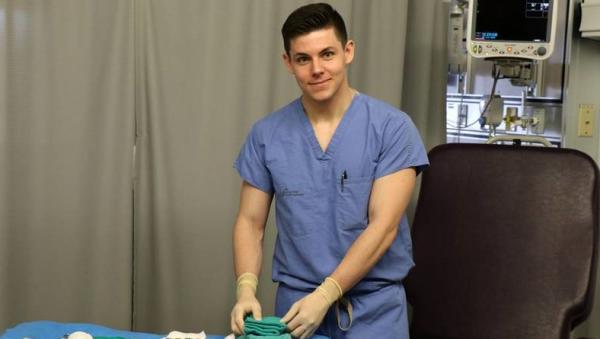Dr. Jack Rasmussen advancing burn care in Nova Scotia through passion and education across the province

Dr. Jack Rasmussen's expertise and training would qualify him for many high-profile positions across Canada and beyond. Fortunately, he opted to stay here in Nova Scotia to establish his medical practice and build capacity for burn care.
“During my residency training, I realized that it would be beneficial to have a physician in Nova Scotia with blended training to manage the unique needs of burn patients,” explained Dr. Rasmussen. “I already had an interest in burn care in my residency. In my role, I have been able to dedicate time to building an interdisciplinary team and advance burn care in Nova Scotia.”
Born and raised in Antigonish, Dr. Jack Rasmussen completed undergraduate studies at Saint Francis Xavier University. He went on to Dalhousie Medical School to complete medical school and residency in Plastic Surgery. In his second year of residency, Dr. Rasmussen completed a rotation in the intensive care unit where he actively participated in the care of patients who suffered severe burns. This moment provided a turning point in his medical career as he found great satisfaction in the high level of complexity involved in this area of medicine.
From there, he went on to pursue an additional two-year fellowship in Critical Care Medicine, with a portion of his training spent at the Ross Tilley Burn Centre at the Sunnybrook Health Sciences Centre in Toronto, Ontario. This highly specialized training equipped Dr. Rasmussen with the skills to work effectively in the ICU setting and manage patients’ after they leave the ICU, facilitating surgeries and overseeing their care as outpatients. After completing this training, he returned to Nova Scotia. In 2018, he joined the Queen Elizabeth II Health Sciences Centre, where he has been actively engaged in the care of burn patients at the hospital ever since.
Dr. Rasmussen is responsible for the well-being of a diverse range of patients with burns. Each week, he will see an average of four to eight outpatients in his clinic with new minor burns. Additionally, he encounters patients with more severe burns requiring admission to hospital. These more serious patients may have burns covering up to 90% of their body. While flame-related burns are the most prevalent, he also treats patients with chemical burns and electrical burns. He also provides consultation support to the IWK in handling their more serious burn cases.
"Once a burn exceeds 20% of the body's surface area, its effects can extend beyond the skin, impacting vital organs such as the lungs, kidneys, and liver," explained Dr. Rasmussen. "Patients with such burns are initially treated in the ICU and subsequently transferred to the burn unit for further care. On average, patients typically spend one day in the hospital for each 1% of their body that is burned, however complex cases can stay in hospital for an extended period.”
Dr. Rasmussen emphasized that burn care requires a comprehensive interdisciplinary team from a variety of disciplines during the patient’s time in hospital. While being treated in hospital, the burn unit benefits from the expertise of an exceptional clinical leader and a dedicated team of nurses with burn care experience. In addition, patients benefit from specialized physiotherapists and occupational therapists provide crucial rehabilitation support and a dietician with a deep understanding of the complex dietary requirements of burn patients. Through collaboration with the acute pain service team, a specialized protocol has been developed to facilitate the delivery of pain medication, which is a crucial aspect of a patient's care, particularly during dressing changes. The team also includes respiratory therapists who assist in the treatment of smoke inhalation injuries, along with anesthesiologists, operating room nurses, social workers and a psychologist who all play a vital role in supporting patients and their families during the transition out of the hospital.
“We also have a remarkable amount of support from our local fire fighters. The Nova Scotia Fire Fighters Burn Treatment Society raises a tremendous amount of funds for burn care in the province, including education and training for healthcare providers, resources for patients during their recovery journey, and special equipment for the burn unit,” said Dr. Rasmussen.
Dr. Rasmussen and the burn care team host an annual Burn Care Education Day. This year, the workshop entered its second iteration, expanding its scope beyond Nova Scotia. Healthcare providers from various disciplines across Atlantic Canada were extended invitations to participate, providing them with valuable opportunities to acquire new knowledge, enhance their skills, and increase their confidence in the treatment of burn patients.
"We present talks from a range of specialists and disciplines to ensure relevance to all participants, whether they are dealing with minor burns at a family medicine clinic or preparing to become clinicians handling burn patients in more advanced stages of recovery,” said Dr. Rasmussen “We have had really high engagement and interest from healthcare professionals across the Atlantic provinces. The education provided facilitates the transfer of patients from the QEII to healthcare facilities nearer to their homes, all while maintaining a consistent standard of care across the province.”
Recently, Dr. Rasmussen was awarded this year's Saint Francis Xavier University’s Young Alumnus Award for his contributions as an alumnus under 40 who embodies the spirit of the university through their actions and accomplishments.
Dr. Rasmussen's unwavering dedication to the well-being of burn patients and their families is palpable in his descriptions of his practice. His passion for excellence in medicine shines through as he speaks about the intricacies of burn care and his commitment to exceptional quality care. As a testament to the world-class care available in the province, he consistently goes above and beyond to provide exceptional medical treatment and support. His commitment extends beyond individual patient care, as he actively seeks to improve burn care throughout the entire province.